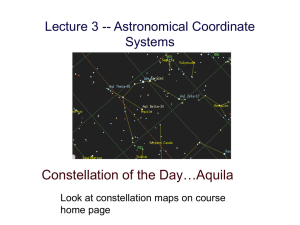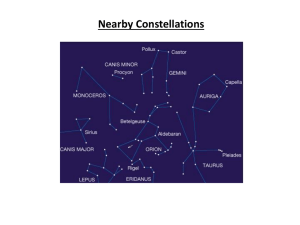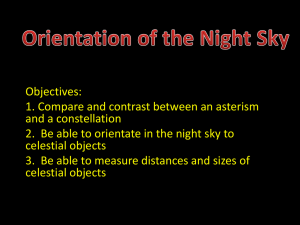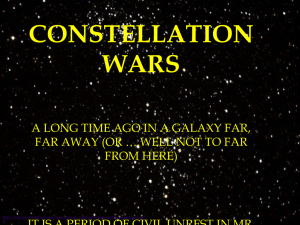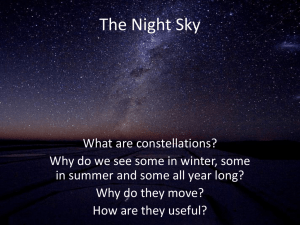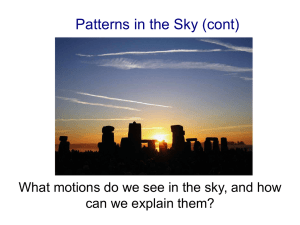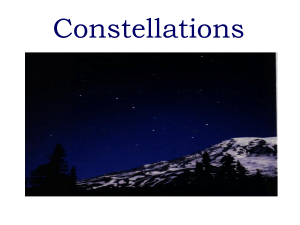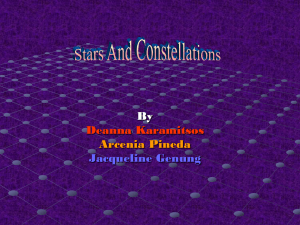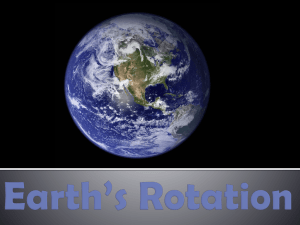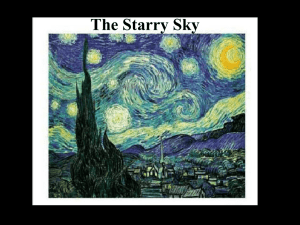Document
advertisement
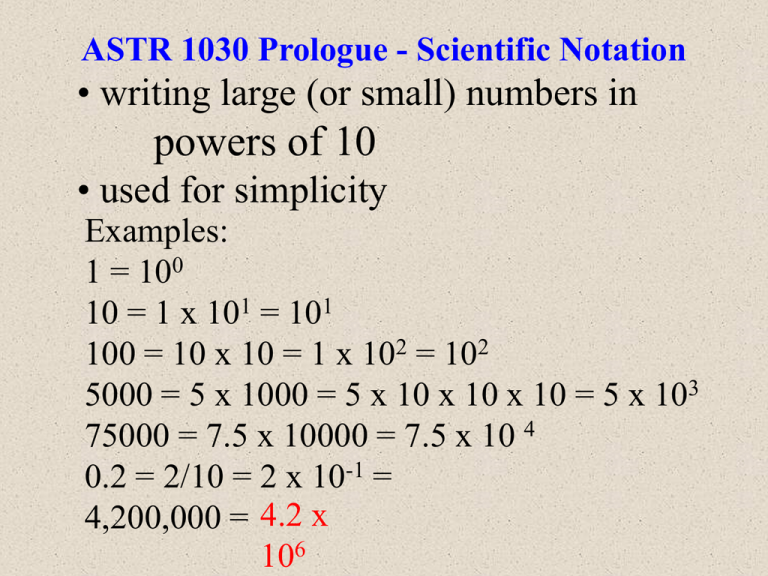
ASTR 1030 Prologue - Scientific Notation • writing large (or small) numbers in powers of 10 • used for simplicity Examples: 1 = 100 10 = 1 x 101 = 101 100 = 10 x 10 = 1 x 102 = 102 5000 = 5 x 1000 = 5 x 10 x 10 x 10 = 5 x 103 75000 = 7.5 x 10000 = 7.5 x 10 4 0.2 = 2/10 = 2 x 10-1 = 4,200,000 = 4.2 x 106 Units of Distance Astronomical Unit (A.U.) = The average distance Earth is from the sun. (know) 1 A.U. = 149,597,900,000 meters So, 1AU ~ 1.5 x 1011 m ~ 1011 meters Light-year (ly) = the distance light travels in one year of time. (know) • Speed of light = 3.0 x 108 meters per second 1 ly = 9.5 x 1015 meters ~ 1016 meters 1 ly = 63,000 A.U. (know) Units of Distance Order of Magnitude Two values are of the same order of magnitude if they are approximately equal (to within one factor of 10). Same order of magnitude? 1400 and 900? YES 1 A.U. and 25 A.U.? no 5.5 x106 and 1.2 x 105? no 8000 mi and 14000 mi? YES (8x103 mi and 14x103 mi) The Grand Tour Smaller • Planets (107 m) • Stars (109 m) • Star Clusters (1011m) • Galaxies (1020m) • Galaxy clusters (1021m) • Superclusters (1024m) • Observable Universe (1026m) Larger (Don’t memorize!) Units of Distance 1020 1026 1015 1010 105 10-5 Orders of Magnitude 10-10 10-15 Distances You Need to Know The diameter of: Earth is about 4 times that of the Moon. Jupiter is about 10 times that of the Earth. the Sun is about 10 times that of Jupiter. The distance to the Sun is about 100 times the diameter of the Sun. DEARTH DJUPITER DSUN 1 AU Pluto’s orbit = 4 Dmoon = 10 DEARTH = 10 DJUPITER = 100 DSUN = 40 AU from the Sun (~size of our solar system) What Science is NOT Philosophy Cultural Beliefs Religion Personal Conditional Emotional Word usage: Theory – the fundamental principles underlying a science, art … such as music theory, germ theory, or theory of equations or gravity. Theory does not convey uncertainty. (The correct word involving uncertainty is hypotheses.) The Scientific Method “Real” World Initial Observations (Assumptions) Model (hypothesis) Compare to Predictions (Test) Observe or Experiment theorize/model predict test modify Revise model to match observations or experiments The Scientific Method Construct Hypothesis, then Conduct Experiment to Test it! Science progresses in a self-correcting manner. No significantly erroneous Initial Observations conclusion or false hypothesis can be (Assumptions) sustained for long as new observations will knock down incorrect ideas. Takes time! Leads to Theory! “Real” World Model (hypothesis) Compare to Predictions (Test) Revise model to match observations or experiments The Scientific Method 1. Why is Astronomy different that any other science in the way in which the scientific method is applied (especially when dealing with stars and galaxies)? In most cases, there is no way to perform an experiment, astronomers can only make observations. Observe theorize/develop model use model to predict test model through observation modify 2. Why is this a valid statement? Theories can be proven FALSE, but never completely true! Equal Theories? Two Equal theories - explain all the observations equally well - explain all the experiments equally well Which is preferred? The simplest one is probably correct! Use the Principle of Parsimony (or Occam’s razor-William of Ockham) - the one with the fewest assumptions (know) Eastern Summer Sky Eastern Winter Sky Constellations Constellations – groups of stars named by ancient cultures to honor gods, animals, legends, etc. • 88 (official) total number • 12 on the zodiac historically 13 on the zodiac today! • Patterns come from star positions ONLY Orion Star Field Constellations Constellations – groups of stars named by ancient cultures to honor gods, animals, legends, etc. • 88 (official) total number • 13 on the zodiac • Patterns come from star positions ONLY Constellation boundaries Constellations – groups of stars named by ancient cultures to honor gods, animals, legends, etc. • 88 (official) total number • 13 on the zodiac today • Patterns come from star positions ONLY • Today a constellation is a region in the sky that is named for an ancient constellation it contains. Constellations Constellations - Groups of bright stars close together that ancient astronomers named after mythological characters. There are 88 official constellations today. Zodiac - The “12” constellations through which the Sun seems to pass as it moves in its yearly path along the ecliptic. Today the zodiac consists of 13 constellations! The 12 classical zodiacal constellations Ophiuchus The Ecliptic Plane Ecliptic – path of the Sun in the sky OR the Earth-Sun plane Ecliptic – the apparent path of the Sun through the “fixed” stars over the course of a year. Long Term Changes - Precession wobble Precession The Earth “wobbles” as it rotates, much like a top. It takes 26,000 years for the Earth to complete one “wobble”. As a result, Polaris will not always be the North Star. As a result, your “sign” is changing. Your Real “Sign” Today • 13 Astronomical Constellations of the Zodiac • Constellation Dates Capricornus January 19 to February 15 Aquarius February 16 to March 11 Pisces March 12 to April 18 Aries April 19 to May 13 Taurus May 14 to June 19 Gemini June 20 to July 20 Cancer July 21 to August 9 Leo August 10 to September 15 Virgo September 16 to October 30 Libra October 31 to November 22 Scorpius November 23 to November 29 Ophiuchus November 30 to December 17 Sagittarius December 18 to January 18 Observations of the Sky • • • • • Is the Earth flat? Why do the stars move/change? What causes the seasons? What causes eclipses? Why does the Moon have phases? Star Trails The Round Earth Observations Solar Eclipse Other celestial bodies Eclipses Disappearing ships Stars disappear as you change position Lunar Eclipse Other celestial objects are round! Earth’s shadow on the Moon is curved during a Lunar eclipse. Motion of the stars Where on Earth is the observer? North Pole Equator The Celestial Sphere • Equator • North Pole • South Pole Definitions: Horizon: The plane tangent to the earth’s surface at the observer’s location. Altitude: An object’s angle above the horizon. Latitude: The altitude of the north star (Polaris) at your location. The north star is always directly above the north pole. Zenith: The point directly above you. 90 The latitude of the north pole is ________ degrees. 0 The latitude of the equator is __________ degrees. The Celestial Sphere • • • • • • • Equator North Pole South Pole Horizon Zenith Altitude Latitude Equinoxes – Sun crosses the celestial equator (twice a year) Spring and Fall. (Spring = Vernal) Solstices – Sun’s farthest northerly or southerly position (Summer or Winter) With respect to the → Northern Hemisphere Equinox – Sun crosses the celestial equator (Spring and Fall) Solstice – Sun’s farthest northerly or southerly position (Summer or Winter) (For the Northern Hemisphere) Locating objects in the sky Geographers use Longitude and Latitude to specify locations on Earth. Astronomers specify the location of objects in the sky using the celestial coordinates of Right Ascension and Declination. Right Ascension: (RA) is measured in angular units of hours, minutes and seconds and increases in the eastward direction. Zero right ascension is usually chosen to be the position of the Sun in the sky at the instant of the vernal equinox. Declination: (dec) is measured in degrees north or south of the celestial equator. The celestial equator is at dec=0°, while the north celestial pole resides at dec=90°. • • Motions of the Sun Sun Cycles Diurnal – Rotation, Earth spinning, length of a day Annual – Revolution, Earth orbit, length of a year Meridian – North-South line dividing the sky equally Ecliptic – path of the Sun in the sky OR Earth-Sun plane Motions of the Earth At the equator, an object is moving 1000 mph due to Earth’s rotation! Earth orbits the Sun at 66,000 mph! • Diurnal – Rotation, Earth spinning (East), length of a day • Annual – Revolution, Earth’s orbit (East), length of a year Meridian – North-South line dividing the sky equally Ecliptic – path of the Sun in the sky or Earth-Sun plane The earth revolves 360º Eastwardly around the Sun in one year (365.24 days) or 360/365.24 1º per day. Solar and Sidereal Days Solar day – time measured by the Sun’s position Sidereal day – time measured by the position of the stars to the stars Solar and Sidereal Days Sidereal day – time by the stars The earth rotates 360º in one sidereal day of 23hr. 56 min. Solar day – time by the sun The earth rotates 361º in one solar day of 24hr. The time of day for the man is noon in both instances. to the stars The Seasons Factors that cause the seasons? Closer to Sun in Summer? The Seasons The earth is actually closest to the sun in December and farthest from the sun in July (but not by much). The Seasons So, what are the factors that cause the seasons? The Seasons Seasons - caused by 23.5° tilt of Earth’s axis of rotation with respect to the ecliptic. Distance Important? Yes or No Reasons for Warm Days 1. Sun is above the horizon longer in the summer 2. More direct light in the summer - Direct sunlight produces more heat than indirect light The Celestial Sphere • Equator • North Pole • South Pole With a point of light and no other information, you cannot tell how far away it is. (Consider driving at night.) So, how do we determine distance? Measuring using Angles • 360 in a circle • 1 = 60 arcminutes = 60’ • 1’ = 60 arcseconds = 60” Measuring using Angles • 360 in a circle • 1 = 60 arcminutes = 60’ • 1’ = 60 arcseconds = 60” So there are 3600 ? . arcseconds in 1. (Index finger~1˚) (Fist at arms length~10˚) Math Notation The symbol means: “is proportional to”. When dropping an object to the ground, its final speed v is proportional to the initial height h. (As h goes up, v goes up) v h When examining your bank account, the amount of money in savings is inversely proportional to how much you are spending. (As spending goes up, your savings goes down) savings 1 _ buying Angular Size, True Size, and Distance Angle #1 Angle #1 True Size True Size Angle #2 Distance Without knowing distance, the man cannot tell the difference between the size of the red and blue objects. What happens if the red object moves closer? The angular size of the red object increases. The Measurement of Distance Angular Size, True Size, and Distance True Size Angular size Distance Angle #1 Angle #1 Angle #2 Distance True Size True Size Angular Size, True Size, and Distance Angle #1 Angle #1 Angle #2 Distance Angular size True Size Distance True size Angular Size Distance Angular Size True Size True Size Angular Size, True Size, and Distance Distance Angular size True Size Distance increases As the True size increases, the Angular size __________ For a given object, As the Distance increases, the Angular size __________ decreases Angular Size, and Distance (Distance, D = R, Radius of Circle) θ = Angular Size Baseline q Circumfere nce 360 (C=2πR=2πD) Baseline q 2 (Distance) 360 D=? Baseline q D=? This assumes that the Baseline is short compared to D so Baseline is close to the curved distance between observations. 360 Baseline Distance 2 q Distance 57.3 Baseline q Putting it to numbers. What is the size of the moon? θ = angular size q Distance 57.3 Baseline q Distance=57.3° x (True Size/θ) so Size = Distance x (θ/57.3°) Size = Moon’s (radar) Distance x (angular size /57.3°) q = 0.517° (about 1/2 the size of you little finger at arms length) Size = 385,000km x (0.517°/57.3°) = 3474 km Parallax – the apparent change in position of an object due to the change in the location of the observer. Observer A Observer B Why? Stellar Parallax Earth 1 Sun 2 Earth Orbit Parallax - apparent motion of a foreground object with respect to the background as the location of the observer changes. Star Parallax The “nearby” object’s apparent displacement, or shift, relative to the more distant stars. Prologue Makeup of the Universe Scientific Notation (Appendix 1) Units of Distance and Astronomical Measurement (Appendix 2) • Astronomical Unit (A.U.) average Sun/Earth Distance • Light year (LY) = 63,000 AU • Parsec = 3.26 LY • Speed of Light c=3x108m/s =3x105km/s Motion of the Sun Earth’s Motions - rotation - revolution The Seasons Angle, size, distance relation Parallax Look through tables p A-3 to A-6. Prologue-Exploring the Heavens (p 2-21) The Scientific Method Constellations Celestial Sphere - Angles - Celestial Poles, Equator - Zenith - Latitude Read through answers to Concept Check Questions and Self-Test Questions (p AK-1 to AK-5) No problems involving math will be given on tests. (wait) What Time is it? 12:00 am (midnight) It’s time to play … Thanks Playing! What timefor is that couple Earth getting married? Eastward 6 am 6 pm 12:00 pm (noon)
